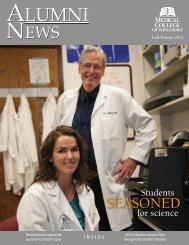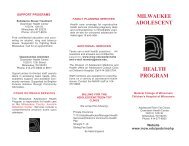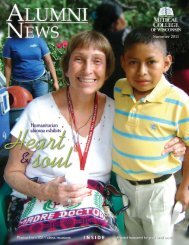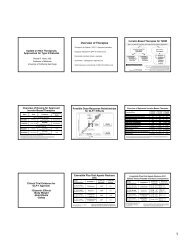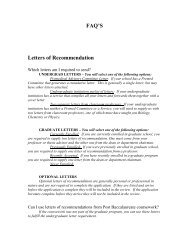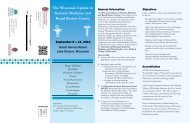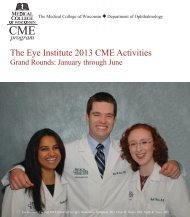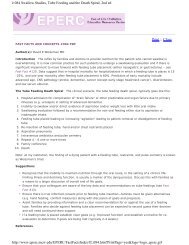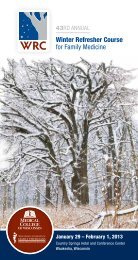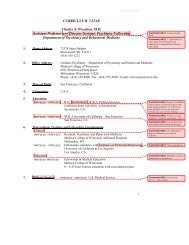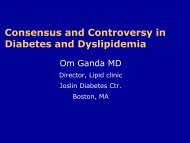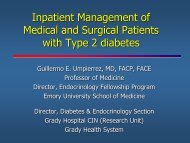2010 Viewbook - Medical College of Wisconsin
2010 Viewbook - Medical College of Wisconsin
2010 Viewbook - Medical College of Wisconsin
You also want an ePaper? Increase the reach of your titles
YUMPU automatically turns print PDFs into web optimized ePapers that Google loves.
<strong>2010</strong> <strong>Viewbook</strong>
As students begin their study <strong>of</strong> medicine atThe <strong>Medical</strong> <strong>College</strong> <strong>of</strong> <strong>Wisconsin</strong>, they discover it to bethe most exciting and challenging experience they have everencountered. <strong>Medical</strong> school, like the practice <strong>of</strong> medicine,is a constantly changing, dynamic process. The <strong>College</strong> createsa stimulating, inspiring learning environment by its focuson academic excellence, supported by a knowledgeablefaculty, high-tech facilities, a superb library, and theavailability <strong>of</strong> research programs for medical students.410111213141618192022Curriculum<strong>Medical</strong> Scientist Training ProgramResearchFacilitiesAffiliatesStudent Affairs/DiversityOpportunitiesAdmissionsFinancial AidMilwaukeeCampus2
welcomeThe <strong>Medical</strong> <strong>College</strong> <strong>of</strong> <strong>Wisconsin</strong> stands well equipped to face thechallenges <strong>of</strong> the medical and scientific questions <strong>of</strong> our century.We invite you to join in this most exciting journey, to learn the science<strong>of</strong> medicine and the art <strong>of</strong> compassion.John R. Raymond, Sr., MDPresident andChief Executive OfficerWe <strong>of</strong>fer an outstanding faculty who will provide you essential guidance,inspiration and leadership in learning. In turn, we expect from ourmedical students a dedication to the calling <strong>of</strong> medicine and acceptance<strong>of</strong> the responsibilities and privileges it affords.Our strength lies not merely in the physical structures <strong>of</strong> our college,but also in the people who comprise The <strong>Medical</strong> <strong>College</strong> <strong>of</strong> <strong>Wisconsin</strong>.Jonathan I. Ravdin, MDExecutive Vice Presidentand DeanWelcome.Karen Marcdante, MDSenior Associate Deanfor EducationThe educational goal <strong>of</strong> The <strong>Medical</strong> <strong>College</strong> <strong>of</strong> <strong>Wisconsin</strong> is toallow our students to become the best physicians possible. Westrive to create an environment that allows our enthusiastic andacademically gifted students to participate in a variety <strong>of</strong> active learningopportunities that prepare them to excel in the care <strong>of</strong> patients whileresponding to the constant changes in medicine. Our large, diversepatient population allows our students to experience the breadth anddepth <strong>of</strong> clinical care needed to meet these goals. The faculty and oureducational administration are dedicated to supporting students as theybecome skilled, compassionate physicians who demonstrate both theart and science <strong>of</strong> medicine, compassion for patients and society and acommitment to lifelong learning. We invite you to join us!3
curriculumOurmissionTo be a nationalleader in the educationand development <strong>of</strong>the next generation<strong>of</strong> physicians andscientists; to discoverand translate newknowledge in thebiomedical sciences; toprovide cutting-edge,interdisciplinary andcompassionate clinicalcare <strong>of</strong> the highestquality; to improvethe health <strong>of</strong> thecommunities we serve.First YearM-1The basic science portion <strong>of</strong> the MD programis taught during the first two years and coversthe fundamental body <strong>of</strong> basic medical scienceknowledge which is the foundation <strong>of</strong> medicalpractice. The learning activities <strong>of</strong> the first twoyears are a mix <strong>of</strong> traditional curriculum formats(lectures, labs, dissection and discussion groups)and newer educational methods—computer-aidedinstruction (CAI), problem-based learning (PBL),and objective structured clinical exams (OSCEs). Aspart <strong>of</strong> the Clinical Continuum, exposure to patientsoccurs as students work with physicians in the <strong>of</strong>ficesetting during the Mentor course allowing studentsto integrate their basic-science knowledge with theclinical practice <strong>of</strong> medicine early in their medicaltraining. Instruction in human behavior including asection on medical interviewing and evidence-basedmedicine completes the M-1 Clinical Continuumcourse. Academic Enrichment Electives, including<strong>Medical</strong> Spanish, Injury Prevention and Control, andHealer’s Art, among others, are available for studentsin their first or second year who wish to pursueinterests beyond the required curriculum.In August <strong>2010</strong>, we began to pilot an IntegratedCurriculum, incorporating active learning methods(Team Based Learning), earlier and more in-depthpatient contact that will continue over the 4 years(the Longitudinal Patient Panel), and competencybasedassessment. Information learned from the pilotcurriculum will allow implementation for the entireM1 class as early as August 2011.Evaluationand GradingMost medical students advance toward theirMD degrees without encountering seriousacademic difficulty. Performance evaluationconducted by faculty members ensures thatstudents have attained sufficient mastery <strong>of</strong> thenecessary material, and the assimilation <strong>of</strong> thatmaterial into their emerging pr<strong>of</strong>essional identityas a physician, before being promoted to the nextlevel <strong>of</strong> study.The <strong>Medical</strong> <strong>College</strong> <strong>of</strong> <strong>Wisconsin</strong> employs thefollowing five-interval grading system:• HonorsSuperior level <strong>of</strong> achievement• High PassClearly better than average performance• PassSatisfactory performance• Low PassBorderline or insufficient performance• FailInadequate performanceEach department or course director writes anevaluation for each student and notes his or herprogress as evidenced from written and oralexaminations and by observation <strong>of</strong> daily workand small-group discussions. Grades are recordedon each student’s permanent record card whichbecomes the academic transcript. Students’academic records are maintained in the Office <strong>of</strong>the Registrar and are made available upon requestby the student in accordance with the provisions <strong>of</strong>the Family Educational Rights and Privacy Act. Allfaculty evaluations are due in the Registrar’s <strong>of</strong>ficewithin one month <strong>of</strong> the completion <strong>of</strong> a course.These forms become a part <strong>of</strong> each student’spermanent record. A copy <strong>of</strong> the evaluation isgiven to each student at the end <strong>of</strong> each course.4
PathwaysStarting in 2009, opportunities for students topursue and strengthen their own interests inspecific areas <strong>of</strong> medicine were created throughdevelopment <strong>of</strong> five “Pathways.” The purpose <strong>of</strong> eachpathway is described below.Master Clinician Pathway allows students to gainin-depth clinical immersion beyond expected medicalstudent competencies to significantly enhance a focus<strong>of</strong> clinical expertise.Urban and Community Health Pathway promotesactive and collaborative community-based engagementfor students interested in careers focused on care forthe underserved.Physician Scientist Pathway provides progressiveopportunities to engage in leading-edge science forstudents aspiring to advance medical knowledgethrough basic science or clinical research.Clinician Educator Pathway allows students t<strong>of</strong>ocus and learn about the art and science <strong>of</strong> medicaleducation as it applies to teaching patients, peers orother health pr<strong>of</strong>essionals.Global Health Pathway provides studentsopportunities for international experiences and localactivities involving a global community to develop skillsin caring for an increasingly diverse population.The Pathways start in the fall <strong>of</strong> the M1 year with theIntroduction to Pathways, a set <strong>of</strong> required structuredsessions that exposes students to the activities, facultyand community members involved in each <strong>of</strong> the fivepathways. At the end <strong>of</strong> this course, students selecta pathway and participate in a variety <strong>of</strong> activities toachieve their goals. Students will also participate in ascholarly project, presented during their third year todemonstrate their mastery <strong>of</strong> pathway specific skills.Students have the opportunity to switch pathways at theend <strong>of</strong> the year.Educational Mission Statement—<strong>Medical</strong> SchoolThe <strong>Medical</strong> Education Program <strong>of</strong> The <strong>Medical</strong> <strong>College</strong> <strong>of</strong> <strong>Wisconsin</strong> has asits primary mission the provision <strong>of</strong> an excellent educational program withinan environment <strong>of</strong> academic scholarship to produce compassionate andcaring physicians skilled in the science and art <strong>of</strong> medicine, dedicated to theethical and social principles <strong>of</strong> the pr<strong>of</strong>ession and committed to a lifetime <strong>of</strong>continued learning.5
curriculumEducationThere are morethan 1,200 studentsenrolled in educationalprograms at the<strong>Medical</strong> <strong>College</strong>. Thisincludes 817 medicalstudents, and morethan 400 graduatestudents. <strong>College</strong>faculty superviseapproximately650 physicians inresidency trainingand 200 physiciansin fellowship trainingthrough The <strong>Medical</strong><strong>College</strong> <strong>of</strong> <strong>Wisconsin</strong>Affiliated Hospitals.The <strong>College</strong> providescontinuing medicaleducation to morethan 40,000health pr<strong>of</strong>essionalregistrants each year.Second YearM-2<strong>Medical</strong> <strong>College</strong> graduate is prepared toA demonstrate problem-solving and reasoningskills, knowledge <strong>of</strong> normal and abnormal states, theability to acquire and utilize information in the clinicalmanagement <strong>of</strong> patients, and the empathic valuesand caring attitudes that are critical to the effectivepractice <strong>of</strong> medicine. During the M-2 year, studentscomplete the basic science curriculum and transitionto advanced topics in the Clinical Continuum, includingthe acquisition <strong>of</strong> history and physical exam skills,clinical reasoning, ethics and health policy.As we pilot the Integrated Curriculum, M2 studentswill continue to participate in organ/system-basedmodules and the Longitudinal Patient Panel. The finalmodule will provide the opportunity to review the basicand clinical science information in a symptom-basedformat, allowing further development <strong>of</strong> problemsolving skills and preparation for the USMLE Step 1exam.Examinations Administeredby the National Board <strong>of</strong><strong>Medical</strong> Examiners<strong>Medical</strong> students are required to take the United States<strong>Medical</strong> Licensing Examination (USMLE), Steps 1,2CK and 2CS, administered by the National Board <strong>of</strong><strong>Medical</strong> Examiners (NBME) and have their scoresreported to the <strong>Medical</strong> <strong>College</strong>. Second-year studentsnormally take Step 1 in June, upon completion <strong>of</strong> theirM2 year. All students must pass the Step 1 examinationbefore they can be promoted to the fourth-yearcurriculum. Fourth-year students must take and passthe USMLE Step 2 Clinical Knowledge (CK) examinationprior to graduation. All students must take and reporta score for the USMLE Step 2 Clinical Skills (CS)examination prior to graduation. The score earnedon Step 2 (CS) may be considered by the AcademicStanding Committee in making graduation decisionsregarding a student’s academic standing.ClinicalContinuumThe Clinical Continuum is an integratedsequence <strong>of</strong> learning activities extendingover the first two years <strong>of</strong> medical school. It isdesigned to provide students with opportunitiesto learn and demonstrate some <strong>of</strong> the essentialknowledge, skills, and attitudes <strong>of</strong> the physicianin the 21st century. The instructional activitiesin most units <strong>of</strong> this course present studentswith interactive, experiential, and clinicallyrelevant opportunities to develop the skillsand identity <strong>of</strong> a physician. The individualcomponents <strong>of</strong> the course are described below:• Mentor. Each student is assigned to aphysician who functions as a mentor (teacher,friend, confidant, and advocate) for thestudent. By participating in monthly visits to thementor’s <strong>of</strong>fice, students can directly observethe practical application <strong>of</strong> some <strong>of</strong> theirclassroom learning. The students also learnthe elements <strong>of</strong> doctor-patient relationshipsand pr<strong>of</strong>essional communication skills withinthe context <strong>of</strong> a growing student-mentorrelationship.• Foundations <strong>of</strong> Human Behavior.This unit provides students with an effectiveknowledge base in normal human personalitydevelopment, the psychological basis <strong>of</strong>behavior, death and dying, human sexualityand the role <strong>of</strong> relationships within familygroups. Instructional activities include lectures,illustrative interviews, small group discussionsand a structured series <strong>of</strong> practice interviews <strong>of</strong>standardized patients.• Foundations <strong>of</strong> Evidence-BasedMedicine. This course introduces someessential concepts <strong>of</strong> study design, statisticalmethods, epidemiology and diagnostic testcharacteristics. Through lectures, onlinemodules and small group discussions, studentswill analyze biomedical research publicationsand apply the findings to clinical situations.6
Units in the second year <strong>of</strong> the ClinicalContinuum include:• Clinical Exam and Reasoning (CER).In this course, students learn the skills <strong>of</strong> asystematic approach to acquiring importantmedical data through the patient’s history and thephysical examination. <strong>Medical</strong> communicationskills, psychomotor examination techniques, andreal-time interpretation and data analysis areimportant course goals.• <strong>Medical</strong> Ethics and Palliative Care.Through a combination <strong>of</strong> lectures, paneldiscussions, and effective small groupinstruction, students are presented with apractical introduction to the current body <strong>of</strong> legaland ethical foundations <strong>of</strong> the practice <strong>of</strong> modernmedicine. Students learn to address a number<strong>of</strong> controversial and ambiguous moral questionsdrawn from today’s real clinical practice.• Health Policy. This brief unit presents anoverview <strong>of</strong> some <strong>of</strong> the political, economic, andsocial forces that influence the current and futurepractice <strong>of</strong> medicine.In the pilot Integrated Curriculum, students willgain the knowledge, skills and attitudes currentlycovered in the Clinical Continuum during thefour year Longitudinal Patient Panel.Students will follow a cohort <strong>of</strong> patients throughthe medical system throughout these four yearsand participate in a variety <strong>of</strong> activities to masterthe psychomotor skills needed to provideoutstanding patient care.STAR CenterThe Standardized Teaching Assessment Resource (STAR) Center provides acontrolled environment where students, residents, physicians, nurses, and otherhealthcare pr<strong>of</strong>essionals can practice their clinical skills using standardized (oractor) patients, medical simulators and task trainers under the direction <strong>of</strong>MCW faculty and staff. In the STAR Center, students have the opportunity topractice interacting with and caring for patients in a safe learning environment.By using medical simulators as they learn new procedures, students and medicalpr<strong>of</strong>essionals can make mistakes without putting patients or themselves at risk.7
curriculumThird YearM-3A treasurein our midstThe <strong>Medical</strong> <strong>College</strong>’ssingular status as theonly medical schooland academic medicalcenter in Milwaukee andsoutheastern <strong>Wisconsin</strong> is adistinct advantage, allowingstudents to stay on campusto receive an excellentclinical experience.During the third and fourth years, the educationalsetting moves to hospitals and outpatient clinics,as students rotate through required clinical clerkshipson the medical center campus, in the Milwaukee areaor rural sites in <strong>Wisconsin</strong>. The required clerkshipsprovide fundamental training in the major fields <strong>of</strong>medicine while also assisting students in evaluatingcareer options. Also, elective clerkships are availableon the medical center campus and may be takenin lieu <strong>of</strong> the scheduled vacation period. Studentsexperience significant participation in patient care,both as individuals and as team members. Duringthe third year, students rotate in pediatrics, internalmedicine, surgery, obstetrics/gynecology, familymedicine, psychiatry, neurology and a rotationin resuscitation and perioperative medicine withexposure to anesthesiology, emergency medicine,and trauma surgery. Students work in hospitals aspart <strong>of</strong> the medical teams that also include fourthyearstudents, residents and attending physicians. Thevolume and diversity <strong>of</strong> patients and their conditions<strong>of</strong>fer outstanding opportunities for doctors in training,providing strong clinical experiences related to theschool’s position in a nationally recognized regionalmedical center.In addition to patients, third-year students continue towork with standardized patients. These individuals aretrained to present as patients with specific problems andto evaluate the students’ performance. This program isused to educate and evaluate, allowing detailed feedbackon clinical skills.All third-year students are required to pass acomprehensive Objective Structured ClinicalExamination (OSCE) <strong>of</strong>fered in the spring <strong>of</strong> the thirdyear. This OSCE assesses basic competencies andensures that students have been exposed to a highstakesexamination using standardized patients similarto the USMLE Step 2 CS exam. The <strong>College</strong>’s philosophy<strong>of</strong> faculty accessibility and collegiality is evident in theclinical setting, whether in a hospital or an outpatientsetting.In addition to the more than 1,450 full-time, parttime,and visiting faculty, more than 1,000 physiciansfrom the community annually volunteer their time inlectures and clinics. All this directed preparation leads<strong>Medical</strong> <strong>College</strong> students to become skilled physicianswith extensive scientific knowledge and comprehensiveclinical experience. They are adept at managing patients,effective at working with other health pr<strong>of</strong>essionals andresourceful in discovering optimal community resourcesfor their patients.8
Fourth YearM-4During the fourth year, students consolidatethe knowledge and practice the skills theyhave acquired during the third year. Four months<strong>of</strong> required rotations are complemented by fivemonths <strong>of</strong> elective experience. Students assumetwo subinternship responsibilities during requiredrotations in a medically oriented specialty (InternalMedicine, Family and Community Medicine andPediatrics) and a surgically oriented specialty(Surgery, surgical subspecialties, Obstetrics andGynecology, and Anesthesiology). Students work asmembers <strong>of</strong> hospital ward teams diagnosing andtreating commonly encountered medical problemsunder supervision, but with increasing patientcare responsibilities. Students attend rounds andconferences, building upon the third-year clerkshipexperiences. To complete their requirements, fourthyearmedical students participate in an ambulatoryexperience in a medical specialty.The final requirement consists <strong>of</strong> an IntegratedSelective designed to approach patient care in amulti-disciplinary manner or to integrate basicscience knowledge with clinical practice. Examples,among many, include women’s health, management<strong>of</strong> breast disorders, or mechanisms <strong>of</strong> disease in anaging population.Five elective rotations complete the requirements <strong>of</strong>the undergraduate medical curriculum. The <strong>Medical</strong><strong>College</strong> <strong>of</strong> <strong>Wisconsin</strong> <strong>of</strong>fers more than 200 electivesin 20 different departments. Students may select fromany specialty or subspecialty, ranging from advancedgross anatomy to neurosurgery. Additionally, studentsin good academic standing may take up to four <strong>of</strong>the five electives <strong>of</strong>f-site. As a result, students arewell prepared for graduate training when they leavethe <strong>Medical</strong> <strong>College</strong>. Moreover, <strong>Medical</strong> <strong>College</strong>graduates are prepared to be life-long learners,having acquired the critical and analytical thinkingskills required by the field <strong>of</strong> medicine today.Patient ServicesApproximately 1,200 <strong>Medical</strong> <strong>College</strong> <strong>of</strong> <strong>Wisconsin</strong> physicians provide adult patientcare as the <strong>Medical</strong> <strong>College</strong> Physicians and pediatric patient care through Children’sSpecialty Group, a joint venture with Children’s Hospital and Health System. The<strong>Medical</strong> <strong>College</strong> <strong>of</strong> <strong>Wisconsin</strong> physician practice includes doctors in every specialtyand subspecialty <strong>of</strong> medicine. Each year, <strong>Medical</strong> <strong>College</strong> <strong>of</strong> <strong>Wisconsin</strong> physicians,physician assistants, nurse practitioners and psychologists care for more than 390,000patients, representing nearly 1.6 million patient visits. <strong>Medical</strong> <strong>College</strong> <strong>of</strong> <strong>Wisconsin</strong>physicians practice at three major affiliates—Froedtert Hospital, Children’s Hospital <strong>of</strong><strong>Wisconsin</strong>, and the Zablocki VA <strong>Medical</strong> Center—and many other hospitals andclinics in the Milwaukee area.9
mstpFacultyThe <strong>Medical</strong><strong>College</strong> <strong>of</strong> <strong>Wisconsin</strong>has approximately5,200 faculty and staffand is the 10th largestprivate employerin MetropolitanMilwaukee. There aremore than 1,450 fulltimeand part-time faculty(MDs, PhDs andother degrees).In addition,approximately 1,000physicians from thecommunity serve asvolunteer faculty.<strong>Medical</strong> ScientistTraining ProgramResearch opportunities abound for medical studentsas part <strong>of</strong> the regular curriculum or as specializedoptions coordinated with medical school training.The <strong>Medical</strong> Scientist Training Program (MSTP) isa special curricular track designed for students whodesire to become biomedical research scientists aswell as competent clinicians. The program providesthe opportunity for highly motivated students tocomplete a course <strong>of</strong> study leading to both the Doctor<strong>of</strong> Philosophy and the Doctor <strong>of</strong> Medicine degrees. TheMSTP provides the in-depth training for a career inresearch as well as the acquisition <strong>of</strong> knowledge andskills for the practice <strong>of</strong> medicine.Applications for admission must be filed separatelyfor both the MSTP and the <strong>Medical</strong> <strong>College</strong> by the falldeadlines set each year. Successful candidates mustmeet criteria for acceptance into the MD programas determined by the <strong>Medical</strong> <strong>College</strong>’s AdmissionsCommittee. Students accepted into the programundertake two research rotations in laboratories<strong>of</strong> their choosing during the summer prior to theirmedical school matriculation and at the end <strong>of</strong>their freshman year. Following their second year <strong>of</strong>medical school, trainees enter the Graduate School<strong>of</strong> Biomedical Sciences for advanced graduate coursework and a PhD dissertation-level research projectconducted under the supervision <strong>of</strong> a faculty member ina graduate program <strong>of</strong>fering the PhD degree. If desired,MSTP students also have the opportunity to begin M3clinical clerkships during their graduate studies. TheMSTP allows integration <strong>of</strong> graduate and M3 curricula,creating additional time for research in the M3 year.After finishing the PhD requirements <strong>of</strong> the GraduateSchool, the trainee completes the clinical clerkshipsand electives which comprise the last two years <strong>of</strong>medical school.Throughout the program, a monthly MSTP StudentSeminar Series provides a format for studentsto discuss their research. Students also have theopportunity each month to meet and discuss theresearch <strong>of</strong> visiting clinician scientists from across theUnited States in the MSTP Visiting Pr<strong>of</strong>essor Series.Trainees receive full tuition support, paid healthinsurance, and an annual stipend commensurate withsimilar training programs. This support is providedthroughout the period <strong>of</strong> their training.The <strong>Medical</strong> Scientist Training Program trainees haveperformed in an outstanding manner in the academicprograms <strong>of</strong> both the medical and graduate schools.Multiple students have been recognized nationallyfor their research accomplishments. The graduates<strong>of</strong> the program have obtained positions in highlyregarded postgraduate training programs throughoutthe United States and have been appointed to medicalschool faculties. For more information about the MSTPprogram, contact:<strong>Medical</strong> Scientist Training Program<strong>Medical</strong> <strong>College</strong> <strong>of</strong> <strong>Wisconsin</strong>8701 Watertown Plank RoadMilwaukee, <strong>Wisconsin</strong> 53226Phone: (414) 955-8641 (800) 457-2775Fax: (414) 955-6345E-mail: mstp@mcw.eduwww.mcw.edu/mstp10
esearchResearchResearch opportunities at the <strong>Medical</strong> <strong>College</strong>abound for medical students. Some participatein its Summer Research Program which <strong>of</strong>fers basicscience or clinical research projects. Several studentshave won regional and national research awards fortheir work.Summer Research ProgramThe goal <strong>of</strong> the <strong>Medical</strong> Student Summer ResearchProgram is to provide early-year medical students withopportunities to explore research and potential careersin research and academic medicine during a criticalperiod <strong>of</strong> career decision-making. A limited number<strong>of</strong> 8-12 week full-time fellowships are competitivelyawarded each year to M1s and M2s, who are interestedin participating in a hands-on basic science, clinicalor translational laboratory research experience,supervised by a full-time <strong>Medical</strong> <strong>College</strong> investigator.Fellows are fully integrated into the research team andare exposed to the protocols and tools <strong>of</strong> the researchenvironment, while developing mentoring relationshipswith their preceptors and learning new skills typicallynot covered in the regular curriculum.Honors In ResearchUpon completion <strong>of</strong> the summer research program,students may optionally apply for the Honors inResearch distinction, a program requiring thecompletion <strong>of</strong> 16 weeks <strong>of</strong> laboratory research and thesubmission <strong>of</strong> an approved research thesis by the fall<strong>of</strong> the M4 year. Honors candidates also must maintainan acceptable academic record throughout the fullmedical school program. Individuals who successfullyfulfill these requirements are recognized at graduation.Research FundingThe <strong>Medical</strong> <strong>College</strong> <strong>of</strong> <strong>Wisconsin</strong> is a major national research center, in fact,the largest research institution in the Milwaukee metro area and 2nd largest in<strong>Wisconsin</strong>. In FY 2008-09, faculty received approximately $157 million in externalsupport for research, teaching, training and related purposes, <strong>of</strong> which approximately$142 million is for research. This total includes highly competitive research andtraining awards from the National Institutes <strong>of</strong> Health (NIH).In the federalgovernment’s FY 2009, the <strong>College</strong> received $110 million in NIH funding and ranked43rd among the nation’s 131 medical schools for NIH research funding.The summer fellowships are funded through grantsfrom several federal agencies, such as National Instituteon Aging and National Heart, Lung, Blood Institute, andthrough internal grants and other resources from the<strong>Medical</strong> <strong>College</strong> and several external organizations.Students must select research projects that areconsistent with the disciplines and scientific researchinterests <strong>of</strong> the various funding sources to be eligible toreceive their support.Summer fellowships are competitive. Awards are based on thequality <strong>of</strong> the applicant’s research proposal and the project’srelevance to the research interests <strong>of</strong> the funding source.Fellows must attend a two-day orientation, an ethics course andseveral didactic seminars, write an abstract <strong>of</strong> their research,and prepare a poster for presentation at <strong>Medical</strong> <strong>College</strong> <strong>of</strong><strong>Wisconsin</strong> Research Days in the fall <strong>of</strong> the year. Opportunitiesto publish and present are two important objectives <strong>of</strong> theparticipant’s research training experience.11
facilitiesResearch CentersThe <strong>College</strong>’s research enterprise is focused onstrategic, prioritized areas <strong>of</strong> research involvinginterdisciplinary collaboration among scientistsand physicians with the goal <strong>of</strong> rapidly translatingdiscoveries into advances for patient care. <strong>College</strong>faculty conducted more than 2,500 research studies,including clinical trials, in FY 2008-09. Specializedresearch centers comprising faculty from many areas<strong>of</strong> expertise include:Federally Designated Centers• National Biomedical Electron ParamagneticResonance Center• National Center for AIDS InterventionResearch• National Center for <strong>Medical</strong> Countermeasuresagainst Radiological Terrorism• National Children’s Study - Waukesha CountyVanguard Center• National Clinical and Translational ScienceInstitute <strong>of</strong> Southeast <strong>Wisconsin</strong>• National Injury Research Center• National Research Center <strong>of</strong> Excellence inPediatric Nephrology• <strong>Wisconsin</strong> Center <strong>of</strong> Excellence in GenomicsScience• <strong>Wisconsin</strong> CIREN (Crash Injury Research andEngineering Network) CenterInternational Center• Center for International Blood and MarrowTransplant Research<strong>College</strong> Centers• Cancer Center• Cardiovascular Center• Human and Molecular Genetics Center• Digestive Disease Center• Biotechnology and Bioengineering Center• Clinical and Translational Science Institute• Institute for Health and Society• Center for Imaging Research• Center for Infectious Diseases Research• Neuroscience Research Center• Center for Patient Care and Outcomes ResearchFacilitiesFor more than a century, The <strong>Medical</strong> <strong>College</strong><strong>of</strong> <strong>Wisconsin</strong> and its predecessor medicalschools have provided a rich and dynamic learningenvironment for medical students. The <strong>College</strong> nowenjoys a national reputation for its educationalprograms. The <strong>College</strong> is the academic heart <strong>of</strong> theMilwaukee Regional <strong>Medical</strong> Center (MRMC), amajor medical campus that includes the <strong>College</strong>, itsteaching hospitals and other health care institutions.The <strong>Medical</strong> <strong>College</strong> is located on a suburban 248-acre, park-like campus, only two minutes from thefreeway that links it to downtown Milwaukee, the lakecountry west <strong>of</strong> the city, and the population centers <strong>of</strong>Southeastern <strong>Wisconsin</strong>.Approximately 1,200 <strong>Medical</strong> <strong>College</strong> <strong>of</strong> <strong>Wisconsin</strong>physicians provide adult patient care as the <strong>Medical</strong><strong>College</strong> Physicians and pediatric patient care throughChildren’s Specialty Group, a joint venture withChildren’s Hospital and Health System. The <strong>Medical</strong><strong>College</strong> <strong>of</strong> <strong>Wisconsin</strong> physician practice includesdoctors in every specialty and subspecialty <strong>of</strong> medicine.Each year, <strong>Medical</strong> <strong>College</strong> <strong>of</strong> <strong>Wisconsin</strong> physicians,physician assistants, nurse practitioners andpsychologists care for more than 390,000 patients,representing nearly 1.6 million patient visits. Thisprovides medical students with a broad range <strong>of</strong>substantial clinical experience in a large and diversemetropolitan population.Whether basic scientist or physician, many <strong>Medical</strong><strong>College</strong> faculty are recognized throughout the nationand the world for their expertise and contributionsto biomedical knowledge and patient care. In anacademic medical center setting, faculty pursuemultiple roles—they see patients, teach medical andgraduate students, conduct research, publish papers,speak at national and international conferences, andlead national pr<strong>of</strong>essional societies.The <strong>College</strong> matches its high standards with new, hightechfacilities and a campus with very well-equippedhospitals.The Health Research Center (HRC) is the front doorto the <strong>College</strong>. It features an auditorium as well as12
affiliatesOtherAffiliatesThe <strong>Medical</strong> <strong>College</strong> <strong>of</strong><strong>Wisconsin</strong> maintainsspecialty programaffiliations withhospitals throughout theMilwaukee metropolitanarea, as well as northern<strong>Wisconsin</strong>. Mostsmall group teaching space. The HRC housesteleconferencing and satellite facilities, a bookstore,and expanded space for research in genetics, cancerand medical effectiveness.The <strong>Medical</strong> <strong>College</strong> <strong>of</strong> <strong>Wisconsin</strong> Library systemconsists <strong>of</strong> the Todd Wehr Library located on the thirdfloor <strong>of</strong> the Health Research Center and two branchlibraries located at Froedtert Hospital and Children’sHospital <strong>of</strong> <strong>Wisconsin</strong>. All three libraries providestate-<strong>of</strong>-the-art information resources. The Todd WehrLibrary has over 400 seats, most with natural lighting.The Library’s licensed electronic resources provideaccess to major biomedical databases such as Medline,DynaMed, and MDConsult, as well as access to morethan 6,000 e-journals and 800 e-books. Access toall the libraries electronic resources is available oncampus or remotely through the Library’s proxy server.The Library’s Microcomputer Center as well as theInstructional Computing Laboratories suite at the<strong>Medical</strong> <strong>College</strong> provide students with access to awide range <strong>of</strong> lab-specific and web-based instructionalmaterials, e-mail, the Micros<strong>of</strong>t Office Pr<strong>of</strong>essionalsuite, and other applications. ANGEL, the <strong>College</strong>’se-learning management system, provides access to webbasedcourse content and educational applications thatare available to students at home or <strong>of</strong>f campus throughan internet connection.AffiliatesStudents and faculty easily walk to clinics, labs,and classes at the <strong>College</strong>’s facilities and theother campus teaching and research affiliates. The<strong>Medical</strong> <strong>College</strong> is one <strong>of</strong> six organizations workingin collaboration on the Milwaukee Regional <strong>Medical</strong>Center campus. Most physicians who staff the clinicsand hospitals on campus are full-time faculty physicians<strong>of</strong> the <strong>College</strong>. Other campus organizations (andnumber <strong>of</strong> hospital beds) are: Froedtert Hospital(486), Children’s Hospital <strong>of</strong> <strong>Wisconsin</strong> (296), BloodResearch Institute <strong>of</strong> BloodCenter <strong>of</strong> <strong>Wisconsin</strong>,Curative Care Network and the Milwaukee CountyBehavioral Health Division (270). The <strong>College</strong> and its<strong>Medical</strong> Center affiliates employ approximately 13,000people on campus.These facilities, along with thenearby Clement J. Zablocki Veterans Affairs <strong>Medical</strong>Center, are a mix <strong>of</strong> private and public institutionswhich <strong>of</strong>fer a varied learning experience for students.The <strong>College</strong>’s affiliations also include a number <strong>of</strong> areahospitals and health care facilities. Together, these sitesprovide a large patient census in a metropolitan area <strong>of</strong>more than a million people. As a benefit <strong>of</strong> the diversityin patient population, disease processes, hospitalsand practice settings, students may choose to stay inMilwaukee for all <strong>of</strong> their clinical education. Studentscan also elect clinical rotations at metropolitan andrural private and public hospitals, private physicianor group practices, or low-income clinics for themedically underserved.third-year studentclerkships occur atinstitutions at theMilwaukee Regional<strong>Medical</strong> Center, while alimited number <strong>of</strong>clerkships may becompleted at a majoraffiliated hospital orclinic. Fourth-yearstudents may choosea variety <strong>of</strong> electives inspecialty areas at thesesame institutions,including familymedicine, obstetrics andgynecology, psychiatry,surgery andanesthesiology.13
diversityStudent Affairs/Diversity14The Office <strong>of</strong> Student Affairs/Diversity (OSAD)truly makes a concerted effort to increasethe numbers <strong>of</strong> underrepresentedindividuals in medicine. Through theirmentoring <strong>of</strong> on campus studentorganizations such as La Raza<strong>Medical</strong> Association (LaRaMa)and the Student National<strong>Medical</strong> Association(SNMA)—whose goalsare steeped in thepromotion <strong>of</strong> culturalawareness and thealleviation <strong>of</strong> healthdisparities, the OSADclearly demonstratesthis commitment.In addition, MCWfaculty, staff, andstudents head avariety <strong>of</strong> summerenrichment and afterschool programs aimed atelementary, high school,and undergraduatestudents, which serveto inspire the nextgeneration <strong>of</strong> scientistsand healthcarepr<strong>of</strong>essionals.— Chris Ford<strong>Medical</strong> StudentThe <strong>Medical</strong> <strong>College</strong> <strong>of</strong> <strong>Wisconsin</strong> recognizes theimportance <strong>of</strong> allowing its medical students theopportunity to exchange ideas with others who havetalents, backgrounds, viewpoints, experiences and interestsdifferent from their own. To this end, The <strong>Medical</strong> <strong>College</strong><strong>of</strong> <strong>Wisconsin</strong> is committed to the recruitment, admissionand graduation <strong>of</strong> a diverse student body that will enhanceDiversity in <strong>Medical</strong> Education (DIME). Specifically, studentswho demonstrate experiences in one or more <strong>of</strong> the followingcategories will be deemed to contribute to the diversity <strong>of</strong> The<strong>Medical</strong> <strong>College</strong> <strong>of</strong> <strong>Wisconsin</strong> student body:• Growing up in poverty or in a disadvantagedsocio-economic status;• Being the first person from one’s family to attendcollege or graduate school;• Overcoming education disadvantage (graduatingfrom a high school with littleresources or with a high drop out rate);• Having a primary language other than English;• Living in a rural area; or• Overcoming a significant handicap.A goal <strong>of</strong> the <strong>College</strong> is to further the cultural competency <strong>of</strong>all physicians and to improve access to care for underservedpopulations. Through the Office <strong>of</strong> Student Affairs/Diversity,the <strong>College</strong> makes a special effort to recruit individuals intomedicine and graduate school from the broadest spectrum <strong>of</strong>society. Our <strong>of</strong>fice also provides student counseling for youracademic, personal or other counseling needs. An academicand career development specialist provides tutoring in areassuch as study skills, test-taking strategies and helps developa board preparation course, ensuring students’ ability tomaster the basic and clinical sciences. Application fees forfinancially disadvantaged applicants will receive considerationfor a fee waiver by the Office <strong>of</strong> Admissions contingent uponan AMCAS fee waiver.The Office <strong>of</strong> Student Affairs/Diversity was created tochampion the success <strong>of</strong> students who may have limitedexposure to medical education and to recruit those studentsto The <strong>Medical</strong> <strong>College</strong> <strong>of</strong> <strong>Wisconsin</strong>. Our goal has been toexpand educational opportunities for such students earlyin their education path, thereby increasing the number <strong>of</strong>graduates contributing to medicine. In the creation <strong>of</strong> a morediverse physician and biomedical scientist pool, aggressiveefforts are made to compete for students having diverseexperiences on a national scale and to provide the necessarysupportive services and financial packages to these studentsduring their enrollment at the <strong>Medical</strong> <strong>College</strong>.
The <strong>College</strong> has several enrichment programs forstudents from diverse backgrounds to jump-start theirexperience in medical education.Apprenticeship in Medicine (AIM)• Provide carefully selected high school studentsfrom diverse backgrounds with the opportunity tolearn more about careers in medicine and alliedhealth.• Through an intensive six-week summer program,students participate in a variety <strong>of</strong> “clinical”hands-on experiences.• Participants gain an understanding andappreciation <strong>of</strong> common, important medicalproblems that have an impact on their community.Research Opportunity for Academic Developmentin Science (ROADS)• Recruits students interested in science to serveas research fellows for seven weeks during thesummer. The students are chosen competitivelybased on recommendations, academicaccomplishments, interest and an interview.• Each student assists an MCW faculty investigatorwho acts as their mentor on a current researchproject.• Designed to provide participants with a meaningfulexperience in a health-related field and tostimulate their interest in careers in science,medicine and biomedical research.Sickle Cell Summer for Science Program• Recruits talented high school students toparticipate in research and education <strong>of</strong> sickle celldisease which include clinical training.• Students shadow a member <strong>of</strong> the sickle cell teamin the comprehensive and specialized sickle cellclients, research projects.• Students matched with experienced Center facultymentors, who oversee and integrate the trainee’swork in basic or clinical research, assisted byother trained clinical or laboratory researchpersonnel and didactic training.• Training includes instruction on the narrow andfunction <strong>of</strong> the human body and related diseases,interactive lectures, general lab safety and the use<strong>of</strong> animals in research.American Chemical Society (ACS) – Project SEED• Provides fellowship to an economicallydisadvantaged student to participate in summerresearch at an academic, government or industriallaboratory.• Emphasizes career development and pursuit <strong>of</strong>higher education in natural sciences.Diversity Summer Health-related ResearchEducation Program (DSHREP)• Qualified diverse students are “matched” withfull-time faculty investigators to participate ina research project(s) addressing the causes,prevention, and treatment <strong>of</strong> cardiovascular,pulmonary and hematological diseases.• Experience is supplemented by a weekly seminaron biomedical research issues <strong>of</strong> current interestand a summer seminar on the principles <strong>of</strong>scientific integrity.Environmental Health Sciences Training Program(EHSTP)• Students participate in an independent summerresearch experience directed to the causes,prevention, and treatment <strong>of</strong> environmental healthproblems in the population.• Program aims to enhance the understanding <strong>of</strong>critical issues in environmental health research,furnish students with information about careeropportunities in the environmental sciences andprovide a stimulating educational environment.15
opportunitiesStudent SupportServices16To ensure academic success and completion<strong>of</strong> medical school, several academicsupport programs are available to all studentsonce they matriculate at the <strong>Medical</strong> <strong>College</strong>.Tutoring, group study, learning skills, test-takingstrategies and supplemental instruction are<strong>of</strong>fered, promoting collegiality and enhancing thestudent’s ability to master the basic sciences. Avariety <strong>of</strong> formal and informal activities supportstudent learning. Academic Support Services areprovided for every phase <strong>of</strong> medical education;these services include individual and groupadvising, tutoring during courses, preparingfor licensure examinations, and career advisingregarding specialty and residency programselection. Another important aspect <strong>of</strong> learningis the fostering <strong>of</strong> productive pr<strong>of</strong>essionalrelationships between students and faculty.Student Support Services assists students witha variety <strong>of</strong> activities ranging from studentorganizations to social events, to providinginformation to students. The <strong>of</strong>fice producesthe <strong>Medical</strong> <strong>College</strong> <strong>of</strong> <strong>Wisconsin</strong> Heartbeat,a monthly electronic student newsletter thatpublishes important information submittedby students, staff, student organizations anddepartments <strong>of</strong> the <strong>College</strong>. The <strong>of</strong>fice alsopublishes a student directory and assists studentswith the production <strong>of</strong> a yearbook.Non-academic student support services broadlyenhance student life on campus through socialgatherings, recreation, exercise and healthpromotion activities, leadership and pr<strong>of</strong>essionaltraining, and community service. Creatinga climate receptive to student interests andconcerns maximizes the rich pool <strong>of</strong> talentsamong the student body. <strong>Medical</strong> <strong>College</strong>students have created numerous organizationsthat participate in political, social, religious andcommunity service.Additional support is provided by Student HealthServices and Student Mental Health Servicesthrough the Departments <strong>of</strong> Medicine andPsychiatry. Confidentiality is assured.Opportunities to make new friends<strong>Medical</strong> <strong>College</strong> students comprise a diverse student body with varied backgroundsand perspectives. More than half <strong>of</strong> the 800 medical students come from somewhereother than <strong>Wisconsin</strong>. Those from <strong>Wisconsin</strong> represent every region <strong>of</strong> the state.Most are in their 20s; however, many are in their 30s, having pursued other interests andcareers before attending medical school. Some arrive with a spouse or a significant other,some with a family.Very few places are as diverse in their student population as the <strong>Medical</strong> <strong>College</strong>. Whilemany students have undergraduate degrees in science, others have degrees in the liberalarts. Their backgrounds may be in psychology, music, philosophy, political science orzoology, among many others.Most first-year students come to medical school immediately after college graduation, butothers bring career experiences or advanced degrees to the <strong>College</strong>. Previous occupationsare as diverse as physical therapy, farming, mortuary science and teaching. As a result,their previous life experiences not only enrich their lives but benefit the entire student body.These non-traditional students mingle and share their skills, interests and perspectives.This mix <strong>of</strong> classmates is seen by <strong>College</strong> students as not only interesting, but a distinctadvantage—they realize that they will be dealing with many different kinds <strong>of</strong> people inmedical practice.The school pays particular attention to students with families and is very flexible about thedemands a family can have on a student. Many <strong>of</strong> the student parents use the campus daycare facility. The <strong>College</strong> also <strong>of</strong>fers a social organization for spouses and significant others<strong>of</strong> students so they can meet one another. Friends are easy to make at the <strong>Medical</strong> <strong>College</strong>.A sense <strong>of</strong> family and concern for each other begins early at the <strong>College</strong>. First- and secondyearstudents develop strong friendships as they work together in labs, on volunteerprojects, social outings and in pr<strong>of</strong>essional organizations.The physical facilities are innovative and inviting with such amenities as a full-servicecafeteria, a fitness center and a student lounge.
Opportunities togrowThe <strong>College</strong> encourages its students to enjoy awell-rounded lifestyle while attending medicalschool. A wide variety <strong>of</strong> programs encourage bothpersonal and pr<strong>of</strong>essional growth. These programshelp establish a life-long foundation for students tobecome competent and compassionate physicians.Support services include individual and groupadvising, tutorial support, preparation for licensureexams, and career counseling for residency training.Student life is enhanced by more than 50 studentorganizations and interest groups which provideopportunities for pr<strong>of</strong>essional and leadershipdevelopment, community service, recreation, andfun. Students enjoy an active intramural program,parties, outings to sports events, cultural programs,the all-college annual Variety Fest, and the BlackBag Ball. There are also career-oriented programs,such as family violence educational seminars andAIDS Awareness Week. Community service projects<strong>of</strong>fer many ways for students to give <strong>of</strong> their time andtalents to others.<strong>Medical</strong> students talk with area high school classesabout AIDS and AIDS prevention through the MCWCARES program (<strong>Medical</strong> <strong>College</strong> <strong>of</strong> <strong>Wisconsin</strong>Council on AIDS: Reaching out and EducatingStudents). Many medical students enjoy volunteeringtheir time for the Applicant-Host Program, a studentrunorganization in which a medical student hostsan applicant while in Milwaukee for an admissionsinterview. These volunteer hosts, who are notinvolved in the admissions process, candidly answerapplicants’ questions about our medical school.The strong sense <strong>of</strong> collegiality expressed amongfaculty, staff, and students in the classroom and clinicis also reflected in outside activities and programs.The Student Assembly sponsors various recreationalactivities on campus. They support intramuralvolleyball, football, soccer and basketball teams.These teams play primarily at a nearby recreationcenter where discounted memberships are availableto medical students. An active Student Assemblyenables all students to express individual as well ascollective ideas and concerns.“<strong>Medical</strong> school can easily become overwhelmingand stressful with the amount <strong>of</strong>time spent studying and preparingfor classes; however, The<strong>Medical</strong> <strong>College</strong> <strong>of</strong> <strong>Wisconsin</strong>provides excellent outletsfor us to enjoy ouryears in school. Fromintramural sports andmixers, to picnics andspecial organizations,MCW provides itsstudents with ampleopportunities to relaxand interact with eachother outside <strong>of</strong> theclassroom. The years <strong>of</strong>medical school should bea balance between therigors <strong>of</strong> medical educationand enjoying time spentwith classmates, and I findthat MCW does a greatjob providing that balance forits students.”—Jessica Bartlet<strong>Medical</strong> Student17
admissionsgraded credits in Biology• 8 graded credits in Biologywith in labwith 2 in labgraded credits in Inorganic• 8 graded credits in InorganicChemistry with in labChemistry with 2 in labgraded credits in Organic• 8 graded credits in OrganicChemistry with in labChemistry with 2 in labAdmissionsThe <strong>Medical</strong> <strong>College</strong> <strong>of</strong> <strong>Wisconsin</strong> seeks studentswho are well suited to the competent and ethicalpractice <strong>of</strong> medicine. To be a successful candidate, anapplicant must have a mature sense <strong>of</strong> values, strongacademic credentials with clear evidence <strong>of</strong> leadership,a commitment to community service, and motivation fora career in medicine.All applicants must take the <strong>Medical</strong> <strong>College</strong> AdmissionTest (MCAT). The test is administered a number <strong>of</strong>times throughout the year and at locations throughoutthe country and abroad. Candidates are encouraged totake the test between January and May <strong>of</strong> the year theyplan to apply for admission. The test must be taken nomore than three years prior to matriculation and cannotbe taken any later than the September administration <strong>of</strong>the year before matriculation. More information aboutthe test can be found at www.aamc.org/students/mcat/.Educational RequirementsEligibility to apply requires a minimum <strong>of</strong> 90 undergraduate gradedcredits completed or in progress at a regionally accredited college oruniversity in the United States or Canada, including:graded credits in Physics• 8 graded credits in Physicsgraded credits in English• 6 graded credits in EnglishMath course with minimum• 1 Math course with a minimum<strong>of</strong> high school algebra<strong>of</strong> high school algebraAdvanced Placement (AP) Credit for PrerequisitesBiology: Up to eight credits can be accepted provided an additional labcourse in the area is successfully completed.English: Up to six credits can be accepted.Inorganic Chemistry: Up to eight credits can be accepted provided anadditional lab course in the area is successfully completed.Mathematics: Up to six credits can be accepted.Physics: Up to eight credits can be accepted.How to ApplyApplication for admission must be made through theAmerican <strong>Medical</strong> <strong>College</strong> Application Service (AMCAS).The application is online and can be accessed by goingto www.aamc.org.Applications are to be submitted to AMCAS from June1 through November 1 <strong>of</strong> the year prior to enrollment.Upon receiving the verified electronic application fromAMCAS, the Office <strong>of</strong> Admissions will email the applicantinformation to access the <strong>College</strong>’s online secondaryapplication. Applications are reviewed on a rolling basisby date <strong>of</strong> completion. Favorably reviewed candidatesare selected to interview by strength <strong>of</strong> application anddate <strong>of</strong> completion. Interviews begin in early October.Offers are made on a rolling basis until the class isfilled. Candidates are encouraged to complete theapplication in a timely fashion.A completed application includes:• completed secondary application;• non-refundable application fee or an AMCAS waiver;• required letters <strong>of</strong> recommendation;• <strong>Wisconsin</strong> residency paperwork (if applicable)• Dean’s certification letter (if applicable)• 2” x 2” photograph (optional)Early Decision is an application option and must beapplied for through AMCAS.18
milwaukee20More info onMilwaukeecan be foundonline at:www.onmilwaukee.comwww.milwaukee.orgwww.MetroMilwaukee.orgMilwaukee is a surprise to many non-native,first-year students. A “beer, brat and baseball”image changes quickly at orientation when newcomersdiscover the city’s diversity, sophistication andfriendliness.Milwaukee is home to state-<strong>of</strong>-the-art healthcare, advanced technology, big business, the arts,pr<strong>of</strong>essional sports, and, <strong>of</strong> course, breweries. Withnearly one million residents in the metropolitan area,Milwaukee ranks among the top cities in population inthe U.S.Despite its size, students quickly feel at home inthis city nestled along Lake Michigan’s shoreline.The Milwaukee area is home to 11 colleges anduniversities, including The <strong>Medical</strong> <strong>College</strong> <strong>of</strong><strong>Wisconsin</strong>. Milwaukee <strong>of</strong>fers easy access, affordablehousing, lots to see and do, and a relaxed lifestyle.Many find the cost <strong>of</strong> living is less expensive than inother parts <strong>of</strong> the country, particularly for housing.Students generally are able to find very reasonablehousing rates. Many are assisted in their searchfor a new “home” by the housing directory that ismaintained by the <strong>Medical</strong> <strong>College</strong>’s Office <strong>of</strong> StudentAffairs.A large proportion <strong>of</strong> the area’s economic growthemerges from the high-tech industry, which is makinga worldwide impact. Key areas <strong>of</strong> technologicaldevelopment are electronics, robotics, inventorycontrol, industrial ceramics, medical diagnosticinstruments, systems for factory automation, printedcircuit boards, semiconductors and CAD/CAMprocessing. Milwaukee is one <strong>of</strong> the nation’s largesthigh-tech manufacturing communities in the U.S.
GE Healthcare, located in the Greater Milwaukee area,distinguishes Milwaukee as a world leader in imaging.The <strong>Medical</strong> <strong>College</strong> is proud to collaborate with themin breakthrough research projects.Milwaukee’s vibrant art scene includes aninternationally renowned repertory theater, symphonyorchestra, two opera companies, a nationallyrecognized ballet company and an art museum.Milwaukee is rich in its performing and visual arts.Students find the city <strong>of</strong>fers them many recreationalopportunities that allow pursuit <strong>of</strong> an athletic interest, arelief from study tensions, or an opportunity to socializewith classmates.Milwaukee’s skyline is home to the breathtakingCalatrava addition to the Milwaukee Art Museum onMilwaukee’s shoreline. Designed by Spanish-bornengineer, architect and sculptor Santiago Calatrava, theaddition is the first Calatrava building completed in theU.S. The centerpiece <strong>of</strong> the project is a grand gatheringplace—a transparent structure enclosed by a lightcontrollingsunscreen which can be raised or lowered,creating a dramatic “sculpture” that the architect haslikened to a bird in flight.The Marcus Center for Performing Arts, only 15minutes away from the <strong>College</strong>, features concerts,theater, touring Broadway shows and dance companies.The Marcus Center is part <strong>of</strong> the downtown theaterdistrict, which includes the Milwaukee RepertoryTheater, the Pabst and the Riverside Theaters andthe newly remodeled Milwaukee Theater. An urban,progressive nightlife is found on Milwaukee’s East Side.Jazz and blues are available in the downtown area.Major sports are also <strong>of</strong>fered downtown. Teams play atthe Bradley Center, home <strong>of</strong> NBA basketball (Bucks),IHL hockey (Admirals) and the Marquette Universitymen’s basketball team (Golden Eagles). The U.S.Cellular Arena <strong>of</strong>fers additional events, including NSPLsoccer (Wave), national tennis matches and skatingexhibitions.Ten minutes from the <strong>Medical</strong> <strong>College</strong> is Miller Park,home <strong>of</strong> the Milwaukee Brewers (National League)baseball. In addition, the Pr<strong>of</strong>essional Golf Association(PGA) annually makes a tour stop in Milwaukee for theGreater Milwaukee Open tournament. Stock and Indycars pull up for several USAC and NASCAR-sanctionedracing events, including the Miller 200.Heralded as the “City <strong>of</strong> Festivals,” Milwaukeecelebrates its melting pot heritage throughout the yearwith a delightful procession <strong>of</strong> ethnic and culturalfestivals. These colorful tributes to a cherished pastinclude: Asian Moon Festival, Rainbow Summer, PolishFest, RiverSplash!, Lakefront Festival <strong>of</strong> Arts, BavarianVolksFest, Bastille Days, CajunFest, Festa Italiana,German Fest, African World Festival, PrideFest, IrishFest, Mexican Fiesta, Labor Fest, Oktoberfest, IndianSummer Festival, Arabian Fest and the Holiday FolkFair. This kaleidoscope <strong>of</strong> culture also influences aneclectic array <strong>of</strong> restaurants, art galleries, museumsand performance art throughout the area. The star <strong>of</strong>the summer festivals is Summerfest, the world’s largestoutdoor music festival that attracts nearly a millionmusic fans to Milwaukee’s lakefront for its 11-day run.Another summer favorite is the <strong>Wisconsin</strong> State Fair,also visited yearly by nearly a million people.Many recreational activities spotlight each season:golfing, tennis, swimming, sailing, fishing, in-lineskating, cross-country skiing, skating, biking, and moreare all possible in Milwaukee’s public parks and at thelakefront. Right in the <strong>College</strong>’s back yard is the PettitNational Ice Center where Olympic gold medalists train.Other Milwaukee attractions recognized nationallyinclude Discovery World, the Milwaukee County Zoo,the Milwaukee Public Museum, the Milwaukee ArtMuseum and the Mitchell Park Conservatory (theDomes). All are free or available at reduced ratesat various times to Milwaukee County residents ormembers. Milwaukee’s park system <strong>of</strong>fers year-roundrecreation with its miles <strong>of</strong> bike and hiking trails, manygolf courses, cross-county skiing, ice-skating rinks andice sculpting contests throughout the city and suburbs.21
campusGetting from there to hereLocated just minutes from the beautiful shoreline <strong>of</strong> Lake Michigan, The <strong>Medical</strong> <strong>College</strong> <strong>of</strong> <strong>Wisconsin</strong> is easilyaccessible from the Interstate system:From the north: take I-43 south to Milwaukee to I-94 west (Madison) to U.S. Hwy. 45, go north on Hwy. 45(Fond du Lac) to Watertown Plank Road.From the south: take I-94 west toward Milwaukee to the I-894 bypass (Madison/Fond du Lac), followI-894 north to U.S. Hwy. 45 north, continue on Hwy. 45 north to Watertown Plank Road.From the southwest: take I-43 (Rock Freeway) to U.S. Hwy. 45/I-894 north, go north on Hwy. 45 (Fond du Lac)to Watertown Plank Road.From the west: take I-94 east (Milwaukee) to U.S. Hwy. 45 north, go north on Hwy. 45 (Fond du Lac) toWatertown Plank Road.22
<strong>2010</strong>-2011 <strong>2010</strong>-11ACADEMIC <strong>Medical</strong> School CALENDARAcademic <strong>Medical</strong> Calendar SchoolDAY DATE EVENT CLASS TIMET APRIL 27 REGISTRATION (’12) M-3W JUNE 16 REGISTRATION (’11) M-4(RISING)(RISING)1:00 P.M.3:00 P.M.M-W JUNE 28-30 JUNIOR (’12) TTC COURSEM-38:00 A.M.(Attendance Required)(RISING)TH JULY 1 ROTATIONS BEGINCLERKSHIPS BEGINM-4M-3 8:00 A.M.M-F AUGUST 9 – 13 REGISTRATION/ORIENTATION M-1 8:00 A.M.M AUGUST 16 CLASSES BEGIN M-1 8:00 A.M.M AUGUST 23 REGISTRATION/CLASSES BEGIN M-2 9:00 A.M./ 1:00 P.M.M SEPTEMBER 6 LABOR DAY HOLIDAY M-1, M-2T SEPTEMBER 7 CLASSES RESUME M-1, M-2W SEPTEMBER 15 CONVOCATION/PRESIDENT’SRECEPTIONALLCLASSESTH SEPTEMBER 23 MEDICAL STUDENT RESEARCH DAY ALLCLASSESTH-F NOVEMBER 25-26 THANKSGIVING HOLIDAY M-1, M-2SA-SU DEC 18-JAN 2 WINTER BREAK M-1, M-2F-SU DEC 24-JAN 2 WINTER BREAK M-34:30 P.M.11:00 A.M. - 1:00 P.M.M JANUARY 3 CLASSES/CLERKSHIPS RESUME M-1, M-2,M-3M JANUARY 17 MARTIN LUTHER KING, JR.DAY CELEBRATIONALLCLASSESSA-SU MARCH 12-20 SPRING BREAK M-1, M-24:30 P.M.TH MARCH 17 MATCH DAY M-4 11:00 A.M.M MARCH 21 CLASSES RESUME M-1, M-2F MAY 13 CLASSES END M-2SA-M MAY 14- JUNE 27 CLOSED STUDY PERIODUSMLE, STEP 1M-4NOONM-46:00 P.M.F MAY 20 COMMENCEMENT M-4 3:00 P.M.TH MAY 19 CLINICAL ROTATIONS ENDSENIOR DINNERM-2F MAY 27 CLASSES END M-1W JUNE 15 REGISTRATION (’12) M-4W JUNE 29 CLERKSHIPS END M-3(RISING)3:00 P.M.M -W JUNE 27 – 29 JUNIOR (’13) TTC COURSE(Attendance Required)M-3(RISING)1/15/10 (SUBJECT TO CHANGE)Current calendar can be found online at www.mcw.edu. Follow path from www.mcw.edu toEducation::<strong>Medical</strong> School::Admissions::Academic Calendar
The <strong>Medical</strong> <strong>College</strong> <strong>of</strong> <strong>Wisconsin</strong> is located on the campus<strong>of</strong> the Milwaukee Regional <strong>Medical</strong> Center on 87th Street,just south <strong>of</strong> Watertown Plank Road at 8701 Watertown Plank Roadin Milwaukee.The <strong>Medical</strong> <strong>College</strong> <strong>of</strong> <strong>Wisconsin</strong> does not discriminate, as definedby applicable federal and state law, in admission to, access to, oremployment in its programs and activities. The <strong>Medical</strong> <strong>College</strong> iscommitted to the policy that all persons shall have equal access toits programs and facilities without regard to race, color, religion,In 2007, the Higher Learning Commission <strong>of</strong> the North Centralnational origin, sex, handicap, sexual orientation, or age.Association <strong>of</strong> <strong>College</strong>s and Schools (HLC-NCA) granted reaccreditationto the <strong>Medical</strong> <strong>College</strong> for the longest term possible (10years). The NCA is the accrediting body for all institutions <strong>of</strong> highereducation in the <strong>College</strong>’s geographic region. (NCA, 30 N. La SalleSt., Suite 2400, Chicago, IL 60602-2504, (312) 263-0456.In 2003, the Liaison Committee on <strong>Medical</strong> Education (LCME)awarded full, eight-year accreditation to the <strong>Medical</strong> <strong>College</strong>, themaximum period <strong>of</strong> accreditation. The LCME is the accreditingbody <strong>of</strong> all US medical schools.Office <strong>of</strong> Admissions8701 Watertown Plank RoadMilwaukee, WI 53226P: 414-955-8246F: 414-955-6506E: medschool@mcw.eduwww.mcw.edu/acad/admission© <strong>2010</strong> <strong>Medical</strong> <strong>College</strong> <strong>of</strong> <strong>Wisconsin</strong>



